No products in the cart.

1. Introduction:
Imagine stepping onto a field where drones buzz overhead, sensors embedded in the soil monitor moisture in real time, and data streams from every corner of the land feed a central AI dashboard. This is not science fiction, it’s the emerging reality of the American farm of the future. With mounting challenges like climate change, labor shortages, and rising food demands, traditional farming methods are proving unsustainable. To keep pace, the U.S. agricultural sector is embracing a digital transformation powered by artificial intelligence and data.
AI in agriculture is more than a buzzword, it’s a critical solution driving innovation in crop management, livestock monitoring, and supply chain efficiency. From smart farms using autonomous tractors to precision agriculture systems that optimize every drop of water and seed placement, the tools of tomorrow are being used today. Yet, many farms remain hesitant, uncertain about cost, complexity, or real-world effectiveness.
The future of American farming lies in making data-driven decisions that reduce waste, boost yields, and improve sustainability. This transformation isn’t only about technology, it’s about survival and scalability in a competitive, climate-impacted world.
As we explore this shift in the following sections, we’ll uncover the key forces driving AI adoption, the technologies leading the charge, and real-world success stories that prove smart farming is more than just hype, it’s the new standard.
2. The Driving Forces Behind AI Adoption in Farming
The rapid integration of AI in agriculture is not happening in a vacuum, it’s a direct response to mounting pressures on the American farming system. Farmers today face a perfect storm: erratic weather patterns, shrinking labor pools, rising input costs, and a growing need for sustainable practices. In this high-stakes environment, data-driven decisions are no longer optional; they’re essential.
One of the most urgent drivers is climate change. Unpredictable droughts, floods, and temperature swings make traditional farming methods unreliable. Enter climate-smart agriculture, a movement that leverages AI tools like satellite imagery, weather modeling, and real-time sensor data to help farmers adapt and thrive.
Labor shortages are another persistent issue. As rural populations decline and fewer young people enter farming, the demand for farm automation is rising. AI-powered machines can now plant, irrigate, and harvest with remarkable precision, freeing up human labor for more complex tasks.
Then there’s the push for agricultural productivity. With global food demand expected to rise by 70% by 2050, American farms must find ways to grow more with less. Precision technologies help optimize resource use, reduce waste, and improve yield forecasts.
Economic pressure is also fueling the shift. Farmers adopting AI-based solutions often see returns through reduced input costs and increased efficiency. Government grants and AgTech partnerships further support this transition, making smart farming more accessible.
These converging forces are accelerating the industry’s evolution, making AI not just an innovation but a necessity.
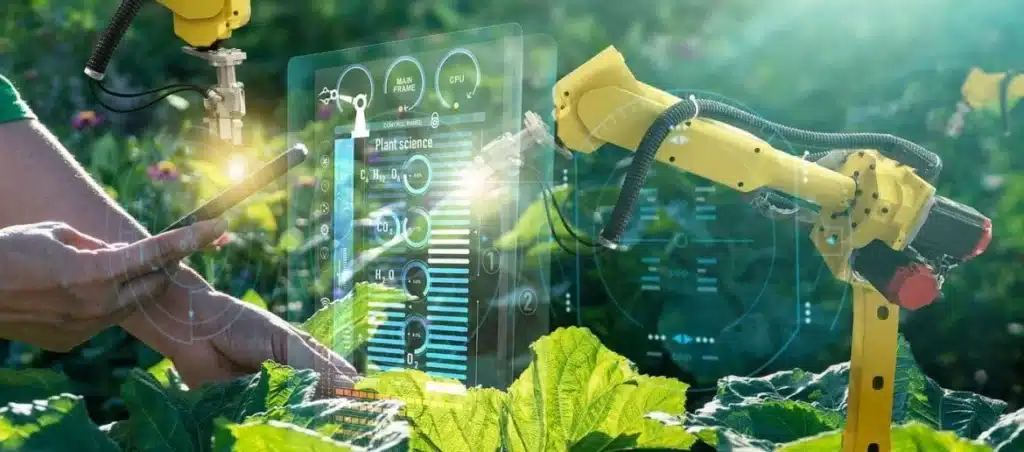
3. Core Technologies Powering the AI-Driven Farm
At the heart of the American farm of the future lies a powerful suite of technologies transforming how agriculture is practiced. These tools are not only advancing productivity, they are revolutionizing the very foundation of precision agriculture.
One of the most impactful technologies is agricultural robotics. From autonomous tractors to robotic weeders, these machines are reducing the need for manual labor while increasing efficiency in planting, spraying, and harvesting. Combined with computer vision in farming, these robots can detect crop diseases, weeds, and nutrient deficiencies with pinpoint accuracy.
Equally transformative are IoT sensors embedded in soil and plants. These devices gather real-time data on moisture levels, pH, temperature, and more, providing the insights necessary for AI crop monitoring. With predictive analytics, farmers can anticipate issues before they escalate, ensuring timely intervention and improved crop health.
Satellite imagery and drone surveillance offer another layer of intelligence. By capturing aerial data, these tools help map fields, monitor crop growth stages, and detect anomalies across vast areas, functions that were previously time-consuming and imprecise.
Central to all of this is machine learning. By analyzing patterns in weather, soil, and crop data, AI systems can recommend the best times to plant, irrigate, fertilize, or harvest. This level of optimization leads to higher yields and more sustainable practices.
Together, these technologies form the digital infrastructure of smart farms, enabling farmers to make faster, smarter, and more profitable decisions.
4. Real-World Examples: Farms Leading the AI Revolution
The shift toward AI in US agriculture isn’t just a theoretical concept, it’s already taking root across American farmlands. From sprawling cornfields in the Midwest to high-tech greenhouses in California, pioneering farms are embracing smart farming solutions and reaping the rewards.
One standout example is Blue River Technology, a California-based farm using computer vision and machine learning to create “see-and-spray” systems. Their AI-driven equipment detects and targets weeds with surgical precision, significantly reducing herbicide usage and operational costs.
In Indiana, a group of soybean and corn farmers has partnered with local AgTech startups to deploy drone-based monitoring systems. These drones collect aerial data to analyze crop health, water stress, and pest infestations, allowing for data-driven agriculture decisions that reduce waste and increase productivity.
Meanwhile, a dairy farm in Wisconsin is using AI-powered wearable sensors on cattle to monitor health indicators like body temperature, rumination, and movement. These tools help detect illness early, improving animal welfare and farm efficiency.
Another forward-thinking project is a collaboration between the USDA and multiple research institutions focused on farm innovation. They’re developing AI models to predict crop yields and weather-related risks, enabling farmers to plan proactively rather than reactively.
These success stories illustrate that the future of American farming is already unfolding. Farms that invest in these technologies are not only improving profitability, they’re building resilience in a volatile agricultural landscape.

5. Economic and Environmental Benefits of AI-Enabled Farming
Adopting AI farming solutions is not only reshaping how crops are grown, but it’s also transforming the economics and sustainability of American agriculture. By fusing technology with tradition, farms are becoming more resilient, more efficient, and more eco-conscious.
One major benefit is cost-effective farming. With AI-driven insights, farmers can reduce their reliance on expensive inputs like water, fertilizers, and pesticides. Smart irrigation systems, for instance, use real-time weather and soil data to deliver water only when and where it’s needed, cutting utility costs and conserving a critical resource.
Then there’s the boost in resource efficiency. AI helps farmers plant at the optimal time, forecast yields with precision, and identify underperforming zones within their fields. These data-backed decisions lead to better crop performance and minimized waste, both in labor and materials.
Beyond the economic upside, AI supports sustainable agriculture by enabling more responsible land stewardship. Practices such as targeted pesticide application and reduced tillage not only save money but also protect soil health and biodiversity. Eco-friendly farming is no longer a luxury, it’s a necessity in the face of climate change and regulatory pressure.
AI also contributes to lower greenhouse gas emissions. Autonomous electric machinery, precision fertilizer usage, and smarter logistics all reduce the carbon footprint of agricultural operations.
As farms become smarter, they also become more aligned with long-term environmental and financial goals. The path to profitability and sustainability is increasingly the same, and AI is making that possible.
6. Challenges and Barriers to Widespread Adoption
While the benefits of AI in agriculture are undeniable, the road to full-scale adoption isn’t without obstacles. Many farmers, especially small and mid-sized operations, face significant technology adoption barriers that slow progress and widen the digital divide in farming.
A primary challenge is the cost of AI tools. High upfront investments for sensors, drones, autonomous machines, and software can be a major deterrent, particularly for those operating on thin margins. Although long-term savings and productivity gains are promising, the initial financial hurdle often leads to hesitation.
Infrastructure is another roadblock. Many rural areas still struggle with unreliable internet access and limited technical support, making it difficult to implement and maintain digital systems. Without a strong digital backbone, AI implementation in agriculture becomes patchy and ineffective.
Lack of knowledge and training also hinders adoption. New technologies often require a steep learning curve. Farmers may be experts in the field, but few have backgrounds in data analysis or machine learning. Without proper training for farmers, even the best tools can remain underutilized.
Additionally, data privacy and ownership concerns present serious considerations. Who owns the data generated by AI systems? How is it used? These questions add complexity to the already challenging process of digital transformation.
Overcoming these barriers will require support from governments, agri-tech companies, and educational institutions. Bridging these gaps is essential to ensure all farmers, not just the tech-savvy or well-funded, can benefit from AI-driven advancements.
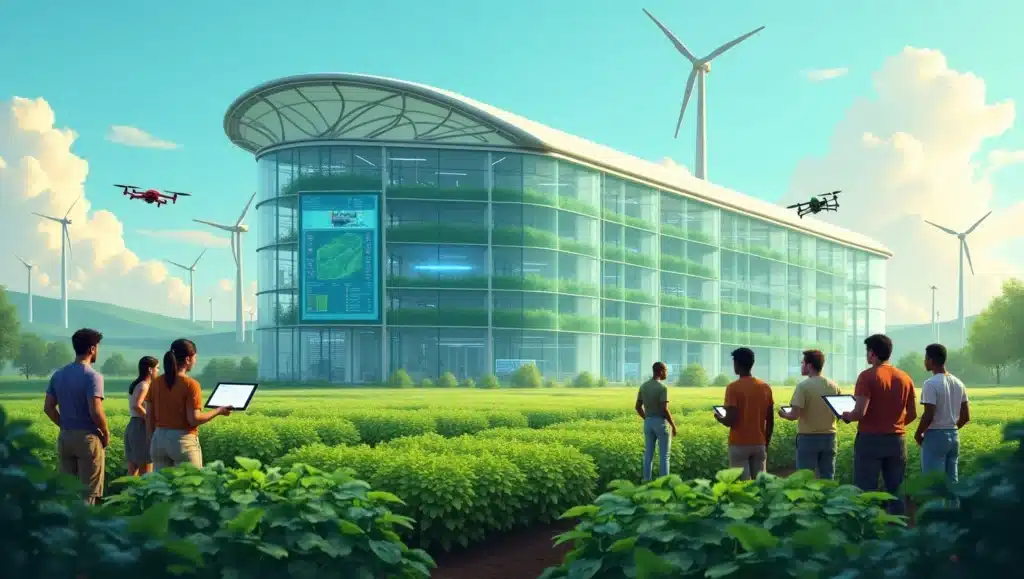
7. The Road Ahead – Policies, Education & Future Trends
As the future of farming continues to evolve, a clear path forward requires the collaboration of farmers, policymakers, and educational institutions. Government support, both in terms of AI policies for agriculture and funding, will be essential in accelerating the transition to AI-driven practices across U.S. farmlands.
At the policy level, more robust incentives are needed to encourage AI adoption, particularly for smaller farms. Subsidies, tax credits, and grants aimed at reducing the upfront costs of technology would help farmers make the leap to smart farming. Additionally, farm policy reform must include provisions that promote the use of data in farming while protecting farmers’ rights to privacy and data ownership.
In parallel, the development of AgTech education programs is critical. Training farmers and the next generation of agri-tech professionals will empower them to embrace AI tools and integrate them into daily operations. Partnerships between universities, government bodies, and technology companies could result in specialized curricula, certifications, and on-farm training sessions that bridge the knowledge gap.
Looking ahead, the AI-driven agriculture trends are poised to expand rapidly. In the coming years, we can expect the rise of autonomous farming systems, more sophisticated predictive analytics, and enhanced machine learning models that offer even greater efficiency and sustainability. Advances in robotics, IoT, and AI-powered forecasting will continue to push the boundaries of what’s possible on the farm.
The future is bright for agriculture if the right policies, education, and innovations come together to support the farmers of tomorrow.
8. Conclusion and Call to Action
The future of farming is not just a vision, it’s unfolding right before our eyes, powered by AI in agriculture and cutting-edge technologies. The transformation from traditional to smart farming is enabling farmers to face the challenges of climate change, resource scarcity, and increasing global demand for food. By embracing data-driven solutions, sustainable agriculture practices are becoming more accessible, ensuring that farms remain profitable and resilient for generations to come.
However, the journey doesn’t end with technology alone. It requires a collective effort to bridge the gaps in education, infrastructure, and policy. Farmers, tech innovators, and government bodies must work together to ensure that AI tools are affordable, accessible, and practical for all types of farms. The AgTech transformation needs to be inclusive, empowering every farmer to make smarter decisions and achieve greater productivity.
As we look ahead, it’s clear that the smart farming revolution is just getting started. The future holds immense potential for those who adopt these innovations, from autonomous machines that streamline operations to AI-powered insights that optimize resources and boost yields. But the road to widespread adoption will require ongoing investment in education, research, and infrastructure.
Now is the time to act. Whether you’re a farmer, a policymaker, or an AgTech entrepreneur, the role you play today will shape the agricultural landscape of tomorrow. Together, let’s build the farm of the future, a farm that thrives on AI-driven solutions and cultivates sustainability, efficiency, and prosperity for all.
FAQs:
Q1. How is AI transforming farming in the United States?
AI is revolutionizing farming by enabling farmers to make data-driven decisions that enhance productivity, reduce waste, and optimize resource use. Technologies such as AI-powered crop monitoring, autonomous machinery, and precision irrigation are helping farmers adapt to climate change, lower costs, and increase yields.
Q2. What are the benefits of AI for sustainable agriculture?
AI promotes sustainable agriculture by improving resource efficiency, reducing the need for pesticides and fertilizers, and minimizing water consumption. With precision farming tools, AI helps farmers adopt eco-friendly practices, such as targeted pesticide application and optimized irrigation, which protect the environment while boosting crop production.
Q3. What are the main challenges to adopting AI in farming?
The main challenges include the high initial costs of AI tools, lack of infrastructure in rural areas, and limited access to internet connectivity. Additionally, there is a need for farmer education and training to effectively use AI technologies. Addressing these barriers is crucial for widespread AI adoption in agriculture.
Q4. How can small farms benefit from AI technologies?
While the cost of AI tools may seem daunting, small farms can benefit from AI through government subsidies, grants, and tech partnerships that help lower initial investments. AI can improve efficiency, reduce operational costs, and increase crop yields, making it accessible and valuable for small farms over time.
Q5. What role will AI play in the future of farming?
AI will play a critical role in the future of farming by driving innovations in farm automation, crop management, and supply chain optimization. As technology advances, AI will enable farmers to make more accurate predictions, improve sustainability, and create more resilient farming systems, ultimately ensuring global food security.
Related Articles
Soil & Water Management
How AI Can Help Young Farmers Succeed in U.S. Agriculture
1. Introduction: Farming in the United States is at a crossroads. With...
Soil & Water Management
AI and Sustainable Farming: Can Technology Save the Planet?
1. Introduction: Can the very industry that feeds the world also be...
Soil & Water Management
AI for Seed Selection: Choosing the Right Crops for Maximum Yield
1. Introduction: Every successful harvest begins with one critical decision, choosing the...
Soil & Water Management
AI in Soil Health: How Smart Tech is Improving Crop Productivity
1. Introduction: Healthy soil is the foundation of a productive farm, but...
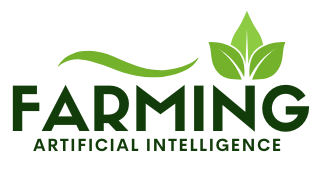

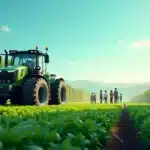
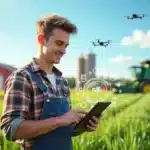

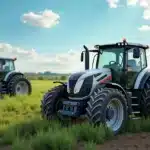

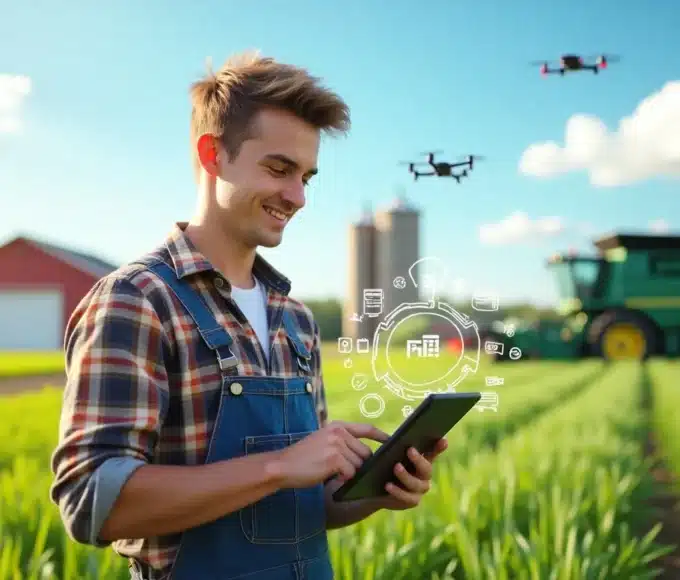
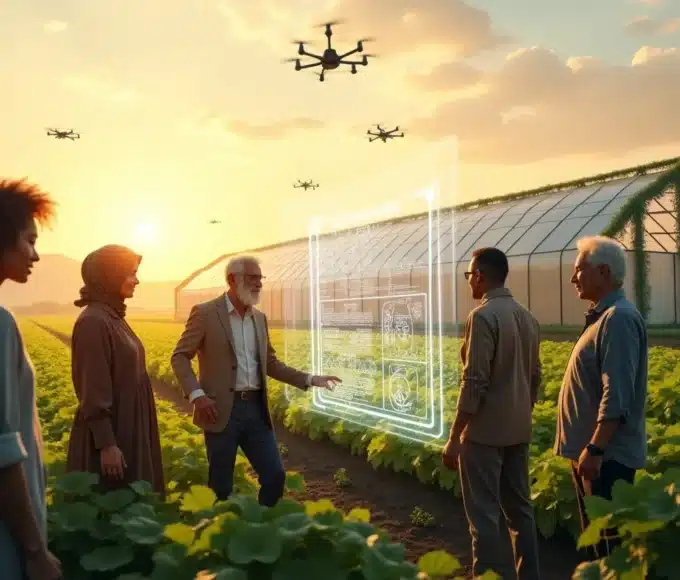
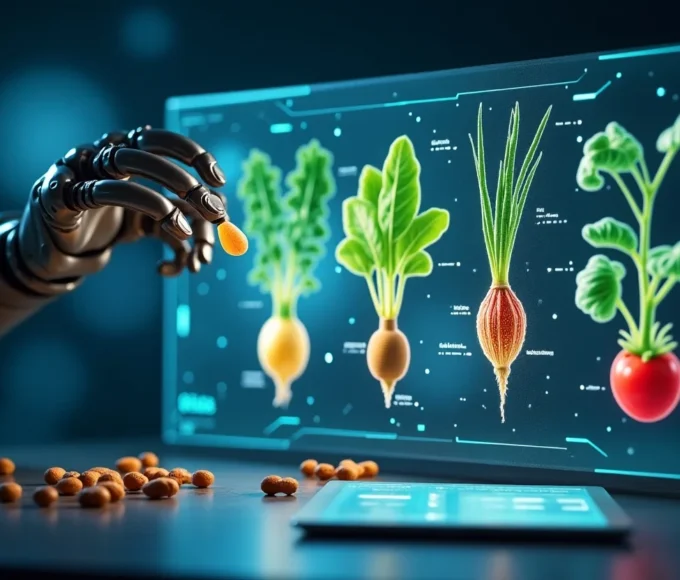
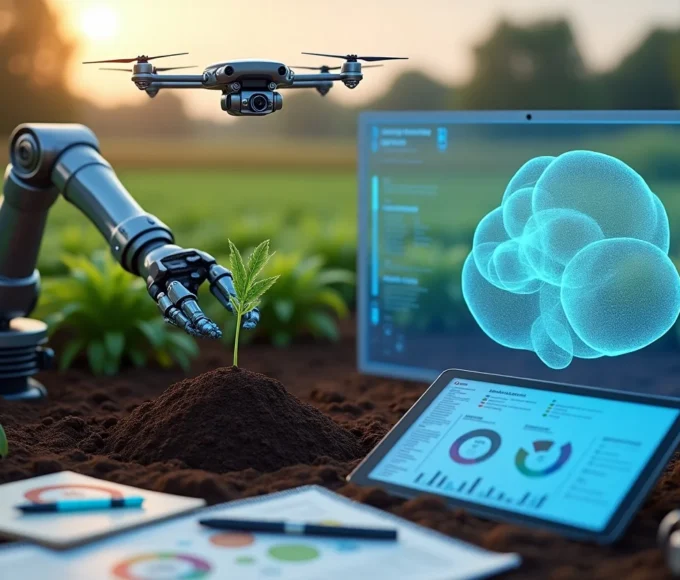
Leave a comment